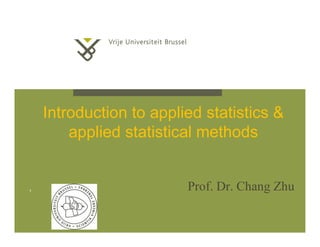
Applied statistics lecture_2
- 1. Introduction to applied statistics & applied statistical methods Prof. Dr. Chang Zhu1
- 2. Aims • Exploring data (descriptive statistics) central tendency data distribution (spread/dispersion) • Testing assumption normal distribution
- 3. population vs. sample • In reality, we can just collect a small subset of the population.
- 4. descriptive vs. inferential • Inferential statistics: draw conclusions based on a data set (sample) to the entire population. • Descriptive statistics: summarize a data set
- 5. descriptive statistics • Measures of central tendency (mean, median, mode) • Measures of spread or dispersion (range, variance, standard deviation)
- 6. measures of central tendency • A researcher is interested in the degree to which a person spends time on Facebook (in hours per week) and the amount of time spent socialising with friends (number of social encounters per month). • He comes up with the following data set. (adapted from http://wps.pearsoned.co.uk/ema_uk_he_dancey_statsmath _4/84/21626/5536329.cw/index.html)
- 7. measures of central tendency P_ID Facebook use Social encounters 1 10 1 2 11 2 3 11 3 4 12 3 5 14 4 6 15 9 7 16 10
- 8. measures of central tendency 10 11 11 12 14 15 16 Facebook use (hours per week) • How many hours do the participants spend on average? (sum = 89) • What is the score that occurs with the most frequency? • What is the score that divides the data into 2 equal halves?
- 9. measures of central tendency 10 11 11 12 14 15 16 Facebook use (hours per week) • Mean: on average = 12.7 • Mode: the most frequency = 11 • Medium: divides the data into 2 equal halves = 12
- 10. measures of central tendency 10 11 11 12 14 15 16 Facebook use (hours per week) • mean = 12.7 • mode = 11 • median = 12
- 11. measures of central tendency – Mean: For normally distributed data, measured as interval and ratio (scales), the appropriate measure of central tendency is the mean. – Median: The median is most appropriate for data measured as ordinal (but can still be used for continuous data) – Mode: is the appropriate measure of central tendency for nominal data.
- 12. measures of spread observed deviance from mean (M = 12.7) squared deviances 10 -2.7 7.29 11 -1.7 2.89 11 -1.7 2.89 12 -0.7 0.49 14 1.3 1.69 15 2.3 5.29 16 3.3 10.89
- 13. measures of spread How representative is the mean? • add up all the squared deviances: sum of squared errors affected by sample size • divide by the number of participants minus 1: variance • square root the variance: standard deviation
- 14. measures of spread • Range: the difference between the highest (maximum) and lowest (minimum) scores. e.g. range = 16-10 = 6 not quite objective, depending on the length of the data set.
- 15. In SPSS Analyse > Descriptive Statistics > Frequencies > Statistics
- 16. SPSS output M = 12.7 SD = 2.28
- 17. Check it! Are the standard deviations correct for gender and modes of learning (full-time/part-time) variables?
- 18. visualize the distribution with histogram Analyse > Descriptive Statistics > Frequencies > Charts
- 19. normal curve visualize the distribution with histogram
- 20. a histogram with normal distribution (bell-shaped) • unimodal (one peak) • symmetrical • centered around the mean
- 22. kurtosis kurtosis: measure the shape of the “bell”
- 23. testing assumption quantifying normal distribution: • the Kolmogorov-Smirnov (K-S) test and the Shapiro-Wilk test: compare the scores of our data set with a normally distributed set of scores with the same mean and standard deviation) • p>.05: non-significant not different: normally distributed • p<.05: significant different : non-normal
- 24. normality assumption • not normally distributed • outliers: a score which is very different from the others • How to identify outliers? Boxplot
- 25. In SPSS Graphs > Chart Builder > Boxplot
- 26. In SPSS Graphs > Chart Builder > Boxplot
- 27. Questions? • Descriptive statistics (mean, median, mode, range, variance, standard deviation) • Skewness/Kurtosis • Histogram to visualize the distribution In SPSS: Analyse > Descriptive Statistics > Frequencies > Statistics/Charts • Test of normal distribution (the K-S test) In SPSS: Analyse > Descriptive Statistics > Explore > Plots> Normality plots with tests
- 28. PRACTICE
- 29. Practice 1 • using the date file sample data 1.sav • conduct the descriptive statistics to explore (the variable named Intrinsic_Motivation_learn) mean, mode, median range, variance, standard deviation draw a histogram to see the frequency of scores
- 30. In SPSS Analyse > Descriptive Statistics > Frequencies
- 31. Frequencies: Statistics dialogue box
- 32. Frequencies: Charts dialogue box
- 35. Practice 2 • using the date file sample data 1.sav • conduct the Kolmogorov-Smirnov (K-S) test and the Shapiro-Wilk test • Are the scores of the variable Intrinsic_Motivation_learn normally distributed?
- 36. In SPSS Analyse > Descriptive Statistics > Explore
- 37. Explore: Plots dialogue box
- 38. Test of normality: results According to the result, the Kolmogorov-Smirnov test and the Shapiro-Wilk test are highly significant, indicating that the distribution of scores for the variable Intrinsic_Motivation_learn is significantly different from a normal distribution. In other words, the distribution is not normal.
- 39. Practice 3 • using the date file SPSSexam.sav • conduct the Kolmogorov-Smirnov (K-S) test and the Shapiro-Wilk test for the variable exam 1. Are the scores of the variable exam normally distributed? 2. Redo the K-S test, this time organize the data by university (Hint: move the variable uni to the Factor List)
